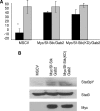A novel Stat3 binding motif in Gab2 mediates transformation of primary hematopoietic cells by the Stk/Ron receptor tyrosine kinase in response to Friend virus infection
- PMID: 17353274
- PMCID: PMC1899994
- DOI: 10.1128/MCB.01838-06
A novel Stat3 binding motif in Gab2 mediates transformation of primary hematopoietic cells by the Stk/Ron receptor tyrosine kinase in response to Friend virus infection
Abstract
Friend erythroleukemia virus has long served as a paradigm for the study of the multistage progression of leukemia. Friend virus infects erythroid progenitor cells, followed by an initial polyclonal expansion of infected cells, which is driven by the activation of a naturally occurring truncated form of the Stk receptor tyrosine kinase (Sf-Stk). Subsequently, the accumulation of additional mutations in p53 and the activation of PU.1 result in full leukemic transformation. The early stages of transformation induced by Friend virus are characterized in vitro by the Epo-independent growth of infected erythroblasts. We have shown previously that this transforming event requires the kinase activity and Grb2 binding site of Sf-Stk and the recruitment of a Grb2/Gab2 complex to Sf-Stk. Here, we demonstrate that Stat3 is required for the Epo-independent growth of Friend virus-infected cells and that the activation of Stat3 by Sf-Stk is mediated by a novel Stat3 binding site in Gab2. These results underscore a central role for Stat3 in hematopoietic transformation and describe a previously unidentified role for Gab2 in the recruitment and activation of Stat3 in response to transforming signals generated by tyrosine kinases.
Figures








Similar articles
-
GRB2-mediated recruitment of GAB2, but not GAB1, to SF-STK supports the expansion of Friend virus-infected erythroid progenitor cells.Oncogene. 2006 Apr 20;25(17):2433-43. doi: 10.1038/sj.onc.1209288. Oncogene. 2006. PMID: 16314834
-
Sf-Stk kinase activity and the Grb2 binding site are required for Epo-independent growth of primary erythroblasts infected with Friend virus.Oncogene. 2002 May 16;21(22):3562-70. doi: 10.1038/sj.onc.1205442. Oncogene. 2002. PMID: 12032858
-
Mutation of the Lyn tyrosine kinase delays the progression of Friend virus induced erythroleukemia without affecting susceptibility.Leuk Res. 2006 Sep;30(9):1141-9. doi: 10.1016/j.leukres.2006.02.006. Epub 2006 Mar 9. Leuk Res. 2006. PMID: 16527351
-
Molecular regulation of receptor tyrosine kinases in hematopoietic malignancies.Gene. 2006 Jun 7;374:26-38. doi: 10.1016/j.gene.2006.01.023. Epub 2006 Mar 9. Gene. 2006. PMID: 16524673 Review.
-
The interaction of the erythropoietin receptor and gp55.Cancer Surv. 1992;15:19-36. Cancer Surv. 1992. PMID: 1451111 Review.
Cited by
-
Oxidative metabolism in cancer: A STAT affair?JAKSTAT. 2013 Oct 1;2(4):e25764. doi: 10.4161/jkst.25764. Epub 2013 Aug 12. JAKSTAT. 2013. PMID: 24416651 Free PMC article. Review.
-
Host genetic background impacts modulation of the TLR4 pathway by RON in tissue-associated macrophages.Immunol Cell Biol. 2013 Aug;91(7):451-60. doi: 10.1038/icb.2013.27. Epub 2013 Jul 2. Immunol Cell Biol. 2013. PMID: 23817579 Free PMC article.
-
The tyrosine kinase sf-Stk and its downstream signals are required for maintenance of friend spleen focus-forming virus-induced fibroblast transformation.J Virol. 2008 Jan;82(1):419-27. doi: 10.1128/JVI.01349-07. Epub 2007 Oct 24. J Virol. 2008. PMID: 17959667 Free PMC article.
-
Function, regulation and pathological roles of the Gab/DOS docking proteins.Cell Commun Signal. 2009 Sep 8;7:22. doi: 10.1186/1478-811X-7-22. Cell Commun Signal. 2009. PMID: 19737390 Free PMC article.
-
The Fyn-STAT5 Pathway: A New Frontier in IgE- and IgG-Mediated Mast Cell Signaling.Front Immunol. 2012 May 11;3:117. doi: 10.3389/fimmu.2012.00117. eCollection 2012. Front Immunol. 2012. PMID: 22593761 Free PMC article.
References
-
- Bentires-Alj, M., S. G. Gil, R. Chan, Z. C. Wang, Y. Wang, N. Imanaka, L. N. Harris, A. Richardson, B. G. Neel, and H. Gu. 2006. A role for the scaffolding adapter GAB2 in breast cancer. Nat. Med. 12:114. - PubMed
-
- Bromberg, J., M. Wrzeszczynska, G. Devgan, Y. Zhao, R. Pestell, C. Albanese, and J. Darnell. 1999. Stat3 as an oncogene. Cell 98:295-303. - PubMed
-
- Casteran, N., P. De Sepulveda, N. Beslu, M. Aoubala, S. Letard, E. Lecocq, R. Rottapel, and P. Dubreuil. 2003. Signal transduction by several KIT juxtamembrane domain mutations. Oncogene 22:4710-4722. - PubMed
Publication types
MeSH terms
Substances
Grants and funding
LinkOut - more resources
Full Text Sources
Other Literature Sources
Molecular Biology Databases
Research Materials
Miscellaneous
